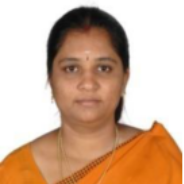
T. Kalaiselvi
Work place: Department of Computer Science and Applications, The Gandhigram Rural Institute - Deemed University, Tamilnadu, India
E-mail: kalaiselvi.gri@gmail.com
Website:
Research Interests: Image Compression, Image Manipulation, Image Processing, Medical Image Computing
Biography
T. Kalaiselvi is currently working as an Assistant Professor in Department of Computer Science and Applications, The Gandhigram Rural Institute, Dindigul, Tamilnadu, India. She received her Bachelor of Science (B.Sc) degree in Mathematics and Physics in 1994 & Master of Computer Applications (M.C.A) degree in 1997 from Avinashilingam University, Coimbatore, Tamilnadu, India. She received her Ph.D degree from The Gandhigram Rural University in February 2010. She has completed a DST sponsored project under Young Scientist Scheme. She was a PDF in the same department during 2010-2011. An Android based application developed based on her research work has won First Position in National Student Research Convention, ANVESHAN-2013, organized by Association of Indian Universities (AUI), New Delhi, under Health Sciences Category. Her research focuses on MRI of human Brain Image Analysis to enrich the Computer Aided Diagnostic process, Telemedicine and Teleradiology Technologies.
Author Articles
Performance of Medical Image Processing Algorithms Implemented in CUDA running on GPU based Machine
By T. Kalaiselvi P. Sriramakrishnan K. Somasundaram
DOI: https://doi.org/10.5815/ijisa.2018.01.07, Pub. Date: 8 Jan. 2018
This paper illustrates the design and performance evaluation of few algorithms used for analysing the medical image volumes on the massive parallel graphics processing unit (GPU) with compute unified device architecture (CUDA). These algorithms are selected from the general framework, devised for computer aided diagnostic (CAD) system. The CAD system used for analysing large medical image datasets are usually a pipeline processing that includes a variety of image processing operations. A MRI scanner captures the 3D human head into a series of 2D images. Considerable time spent in pre and post processing of these images. Noise filters, segmentation, image diffusion and enhancement are few such methods. The algorithms are chosen for study requires local information, available in few pixels or global information available in the entire image. These problems are best candidates for GPU implementation, since the parallelism is naturally provided by the proposed Per-Pixel Threading (PPT) or Per-Slice Threading (PST) operations. In this paper implement the algorithms for adaptive filtering, anisotropic diffusion, bilateral filtering, non-local means (NLM) filtering, K-Means segmentation and feature extraction in 1536 core’s NVIDIA GPU and estimated the speed up gained. Our experiments show that the GPU based implementation achieved typical speedup values in the range of 3-338 times compared to conventional central processing unit (CPU) processor in PPT model and up to 30 times in PST model.
[...] Read more.Brain Tumor Boundary Detection by Edge Indication Map Using Bi-Modal Fuzzy Histogram Thresholding Technique from MRI T2-Weighted Scans
By T. Kalaiselvi P. Sriramakrishnan P. Nagaraja
DOI: https://doi.org/10.5815/ijigsp.2016.09.07, Pub. Date: 8 Sep. 2016
Tumor boundary detection is one of the challenging tasks in the medical diagnosis field. The proposed work constructed brain tumor boundary using bi-modal fuzzy histogram thresholding and edge indication map (EIM). The proposed work has two major steps. Initially step 1 is aimed to enhance the contrast in order to make the sharp edges. An intensity transformation is used for contrast enhancement with automatic threshold value produced by bimodal fuzzy histogram thresholding technique. Next in step 2 the EIM is generated by hybrid approach with the results of existing edge operators and maximum voting scheme. The edge indication map produces continuous tumor boundary along with brain border and substructures (cerebrospinal fluid (CSF), sulcal CSF (SCSF) and interhemispheric fissure) to reach the tumor location easily. The experimental results compared with gold standard using several evaluation parameters. The results showed better values and quality to proposed method than the traditional edge detection techniques. The 3D volume construction using edge indication map is very useful to analysis the brain tumor location during the surgical planning process.
[...] Read more.Other Articles
Subscribe to receive issue release notifications and newsletters from MECS Press journals